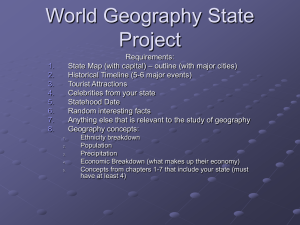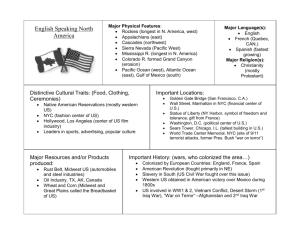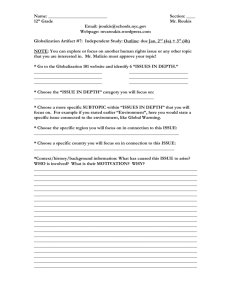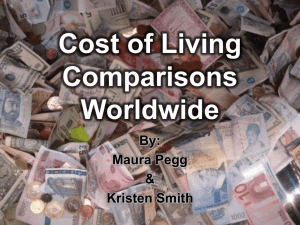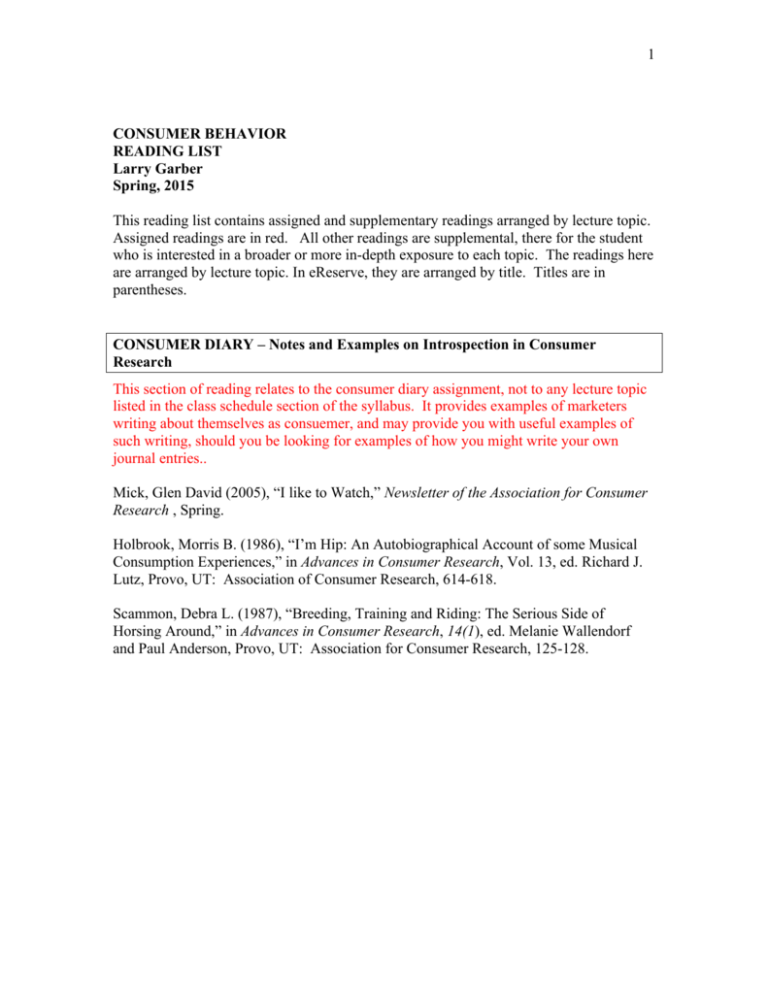
1
CONSUMER BEHAVIOR
READING LIST
Larry Garber
Spring, 2015
This reading list contains assigned and supplementary readings arranged by lecture topic.
Assigned readings are in red. All other readings are supplemental, there for the student
who is interested in a broader or more in-depth exposure to each topic. The readings here
are arranged by lecture topic. In eReserve, they are arranged by title. Titles are in
parentheses.
CONSUMER DIARY – Notes and Examples on Introspection in Consumer
Research
This section of reading relates to the consumer diary assignment, not to any lecture topic
listed in the class schedule section of the syllabus. It provides examples of marketers
writing about themselves as consuemer, and may provide you with useful examples of
such writing, should you be looking for examples of how you might write your own
journal entries..
Mick, Glen David (2005), “I like to Watch,” Newsletter of the Association for Consumer
Research , Spring.
Holbrook, Morris B. (1986), “I’m Hip: An Autobiographical Account of some Musical
Consumption Experiences,” in Advances in Consumer Research, Vol. 13, ed. Richard J.
Lutz, Provo, UT: Association of Consumer Research, 614-618.
Scammon, Debra L. (1987), “Breeding, Training and Riding: The Serious Side of
Horsing Around,” in Advances in Consumer Research, 14(1), ed. Melanie Wallendorf
and Paul Anderson, Provo, UT: Association for Consumer Research, 125-128.
2
INTRODUCTION
What Is Consumer Behavior, and Its Role in Marketing Strategy?
Howard, John A. (1989), “Study of Consumer behavior,” Consumer Behavior in
Marketing Strategy, Englewood Cliffs, NJ, 1-7.
Brief Marketing Review: The Marketing Concept/Consumer Orientation, Target
Segmentation, the Marketing Mix
Belch, George, and Michael Belch (2009), “The Target Marketing Process,” in
Advertising and Promotion: An Integrated Marketing Communications Perspective, 8th
Ed., NYC: McGraw-Hill Irwin, 46-67.
INDIVIDUAL DECISIONMAKING
Decisionmaking
Schiffman, Leon G, and Leslie Lazar Kanuk (2007), “Models of Consumers: Four Views
of Consumer Decision Making,” in Consumer Behavior, 9th ed., Upper Saddle River, NJ:
Pearson Prentice Hall, 528-530.
Stages in the Consumer Choice Process Leading to Adoption
Kotler, Philip, and Gary Armstrong (2014), “Stages in the Adoption Process,” in
Principles of Marketing, 15e, Upper Saddle River, NJ: Pearson, 157.
Hoyer, Wayne D. and Deborah J. MacInnis (2010), “Judgment and Decision Making
Under High Effort,” in Consumer Behavior, 5th Ed., Mason, OH: South-Western Cengage
Publishing, 219-245.
Hoyer, Wayne D. and Deborah J. MacInnis (1997), “Judgment and Decision Making:
Low Consumer Effort,” in Consumer Behavior, 1st Ed., Mason, OH: South-Western
Cengage Publishing, 219-266.
Bettman, James R., Mary Frances Luce, and John W. Payne (1998), “Constructive
Consumer Choice Processes.” Journal of Consumer Research, 25 (3), 187-217.
Pennar, Karen( 1996), “How Many Smarts Do You Have?” Business Week, Issue 3493,
104-107
Goleman, Daniel (1997), “Emotional Intelligence,” in Emotional Intelligence, NYC:
Bantam Books, 27-29, 41-45, 52-54.
Weeks, Richard R., and William J. Marks (1969), “The Marketing Concept in Historical
Perspective, Business and Society, 9(2), 24-33.
3
Borden, Neil H. (1964), “The Concept of the Marketing Mix,” Journal of Advertising
Research, 4(2), 361-369.
(Ir)Rationality
Simon, Herbert A. (1986), “Rationality in Psychology and Economics,” The Journal of
Business, 59 (October), 2-16.
Lee, Leonard, On Amir and Dan Ariely (2009), “In Search of Homo Economicus,”
Journal of Consumer Research, 36(2), 173-187.
Levinson, Marc (1995), “Dismal Science Grabs a Couch,” Newsweek, 125(15). 41-42.
Business Week (2000), “Putting a Human Face on Economics,” July 31, 2000, 78-79.
Time Magazine, “This Crazy Market is Tough to Beat,”
U.S. News and World Report (2005), “Mysteries of the Mind,” February 28, 53-54, 5760.
Wall Street Journal, “Follow Your Intuition: The Unconscious You May be the Wiser
Half,” August 30, 2002.
The Deep Meaning of Possessions
Levy, Sidney J. (1959), “Symbols by Which We Buy,” in Classics in Consumer Behavior
(1977), ed. Louis E. Boone, Tulsa Oklahoma: Petroleum Publishing Company, 3-11.
Wolkomir, Richard, and Joyce Wolkomir, “You Are What you Buy,” Smithsonian, 31(7),
103-109.
Belk, Russell W. (1988), “Possessions and the Extended Self,” Journal of Consumer
Research, 15 (September), 139-168.
Khermouch, Gerry (2001), “Consumers in the Mist: Madison Avenue’s Anthropologists
are Unearthing our Secrets,” Business Week, February 26, 92-95.
Target Segmentation
Hiam, Alexander, and Charles D. Schewe (1993), “Market Segmentation: Can it Work
for your Company?” Incentive, 167 (1), 65-66.
Kropp, Fredric (2003), “Entrepreneurial Marketing: Lessons from Wharton’s Pioneering
MBA Course,” Journal of the Academy of Marketing Science, 31(4), 487-488.
4
Lerer, Leonard (2002), “Pharmaceutical Marketing Segmentation in the Age of the
Internet,” International Journal of Medical Marketing, 2(2), 159-166.
Mendenhall, Michael (2005), “Emotional Equity is Still Disney’s Key Asset,”
Advertising Age, 76 (7), 24.
Karolefski, John (2008), “Walmart Focuses on Improving Customer Experience,”
Supermarket News, December 8, 21-22.
Mass Customization
Cullen, Lisa Takeuchi (2002), “Have it Your Way: From Lipsticks to Cars, A Growing
Array of Products Can be Custom-Made to your Own Taste—and Waist,” Time
Magazine, 160(25).
Kotler, Philip (1989), “From Mass Marketing to Mass Customization,” Planning Review,
17 (Sep/Oct), 10-13, 47.
Pine, B. Joseph, II, Bart Victor, and Andrew C. Boynton (1993), “Making Mass
Customization Work,” Harvard Business Review, 71(5), 108-118.
Wall Street Journal (1995), “Different Strokes: Target ‘Micromarkets’ Its Way to
Success; No Two Stores are Alike,” May 31, A1-A4.
Schlossberg, Howard (1992), “McDonald’s Makes a Science out of Micromarketing,”
Marketing News, 26 (14), 8, 22.
Shermach, Kelly (2005), “Delta Uses Mileage Plan to Boost Customer Sat,” Marketing
News, 39(8), 21, 24.
Johnson, George (2005), “A Customer Base of One: Personal Fabricators Aim at Letting
You Manufacture Your Own Products,” Scientific American, 292(6), 110, 112.
Relationship Marketing
Nelson, Emily (2005), “Walmart Customers Feel Free to spend the Night in the Lot,”
Wall Street Journal, August 9, 1999, Section A, page 1, Column 4.
Antle, Jessica (2005), “Are You Credit Wise? College Outreach Program Demonstrated
the Answer is Yes,” Business Wire, Inc., May 19.
Wansink, Brian (2003), “Using Laddering to Understand and Leverage a Brand’s
Equity,” Qualitative Market Research, 6 (2), 111-119.
Winston-Salem Journal (1999), “Questions Arise as Grocery-Card Use Grows,” Tuesday,
February 9, D1, D6.
5
Weintraub, Arlene (2000), “When E-Mail Ads Aren’t Spam,” BusinessWeek, (October
16), 112, 114.
NEEDS AND MOTIVATION
Sheth, Jagdish, and Banwari Mittal (2004), “Customer Motivation: Needs, Emotions, and
Psychographics,” Customer Behavior: A Managerial Perspective, 2nd Ed., Mason, OH
Thomson Southwestern, 159-171.
Maslow, Abraham H. (1977, 1943), “A Theory of Human Motivation,” in Classics in
Consumer Behavior (1977), ed. Louis E. Boone, Tulsa Oklahoma: Petroleum Publishing
Company, 72-87.
Wells, Melanie (2003), “In Search of the Buy Button,” Forbes Magazines, 172(4), 62-70.
Walsh, Gianfranco, Kevin P. Gwinner, and Scott R. Swanson (2004), “What Makes
Mavens Tick? Exploring the Motives of Market Mavens’ Initiation of Information
Diffusion,” The Journal of Consumer Marketing, 21 (2/3), 109-119.
Greenfield, Karl Taro (1999), “Life on the Edge: Is Everyday Life too Dull? Why Else
Would Americans Seek Risk as Never Before?” Time Magazine, 154(10), 29-36.
MEMORY, INFORMATION PROCESSING : SYSTEM 2
Hoyer, Wayne D., and Deborah J. MacInnis (2004), “Memory and Retrieval,” in
Consumer Behavior, 3rd Ed., NYC: Houghton Mifflin Company, 172-195.
AUTOMATIC PROCESSING: SYSTEM 1
Hoyer, Wayne D., and Deborah J. MacInnis (2007), “Knowledge and Understanding,” in
Consumer Behavior, 4th Ed., NYC: Houghton Mifflin Company, 95-121.
Contrasting Systems 2 and 1
Kahneman, Daniel (2012), “Of 2 Minds: How Fast and Slow Thinking Shape Perception
and Choice,” Scientific American, (6 pages).
Bargh, John (2014), “Our Unconscious Mind,” Scientific American, January, 30-37.
Zaltman (2003), “Consumers’ Cognitive Unconscious,” in How Consumers Think,
Boston: HBS Press, 47-57.
Gladwell, Malcom (2005), “The Statue that Didn’t Look Right,” in blink, NYC: Back
Bay Books, 3-17.
6
Lindstrom, Martin (2008), “I Can’t See Clearly Now: Subliminal Messaging, Alive and
Well,” in Buy-ology, NYC: Doubleday, 68-87.
Borges, Jorge Luis (1964), “Funes, His Memory,” in labyrinths, NYC: New Directions,
131-137. (This essay hypothesizes how human memory could work differently.)
Bettman, James R. (1979), “Memory Factors in Consumer Choice: A Review,” Journal
of Marketing, 43(2), 37-53.
Stayman, Douglas M., Dana L. Alden, and Karen H. Smith (1992), “Some Effects of
Schematic Processing on Consumer Expectations and Discrimination Judgments,”
Journal of Consumer Research, 19 (September), 240-255.
Johnson, George (2000), “Lots of Action in the Memory Game,” Time Magazine
155(24), 54-57.
Connor, Steve (2001), “Adverts Plant Memories of an Imagined Childhood,” The
Independent, 5 September, 2001.
Haney, Daniel (1997), “Scientists Able to Plant Fake Memories,” Charlotte Observor,
February 16, 10A.
Braun, Kathryn, Rhiannon Ellis, and Elizabeth F. Loftus (2002), “Make My Memory:
how Advertising Can Change Our Memories of the Past,” Psychology and Marketing,”
19(1), 1-23.
Evans, Mark (2001), Experts, Amateurs Use Different Parts of the Brain,” Charlotte
Observor, August 10.
Green, J. Roger (2004), “Attention! (How to Interrupt, Yell, Whisper and Touch
Consumers…),” Journal of Consumer Behaviour, 3 (4), 2.
CONSUMER NEUROSCIENCE
Neilsen’s Consumer Neuroscience Pitch. [online] –
http://www.nielsen.com/us/en/solutions/capabilities/consumer-neuroscience.html/
(Accessed February 2015). [Do you believe they can do what they say?]
Lindstrom, Martin (2006), “Buy-ology.” NYC: Doubleday, 23-34.
Satel, Sally, and Scott O. Lilienfield (2013), Brainwashed: The Seductive Appeal of
Mindless Neuroscience,” NYC: Basic Books, ix-xiii, 25-47.
7
Yoon, Caroline, Richard Gonzalez, Antoine Bechara, Gregory S. Berns, Alain A. Dagher,
Laurette Dube, Scott A. Huettel, Jospeph W. Kable, Israel Liberzon, Hilek Plassman, Ale
Smidts, and Charles Spence (2012), “Decision Neursoscience and Consumer Decision
Making,” Marketing Letters, 23, 473-485.
LEARNING, INVOLVEMENT, LOYALTY
Mowen, John C., and Michael Minor (1998), “Behavioral Learning,” in Consumer
Behavior, 5th Ed., Upper Saddle River, NJ: Prentice-Hall, 129-154.
Mowen, John C., and Michael Minor (1998), “How Do Consumers Gain Knowledge:
Cognitive Learning,” in Consumer Behavior, 5th Ed., Upper Saddle River, NJ: PrenticeHall, 107-113.
Assael, Henry (2004), “Consumer Learning,” in Consumer Behavior: A Strategic
Approach, NYC: Houghton Mifflin, 58-87.
McSweeney, Frances K, and Calvin Bierley (1984), “Recent Developments in Classical
Conditioning,” Journal of Consumer Research, 11 (September), 619-631.
Krugman, Herbert E. (1994), “Observations: Pavlov’s Dog and the Future of Consumer
Psychology,” Journal of Advertising Research, 34 (6), 67-70.
Nord, Walter R., and J. Paul Peter (1980), “A Behavior Modification Perspective on
Marketing, Journal of Marketing, 44 (Spring), 36-47.
Gregan-Paxton, Jennifer, Jonathan D. Hubbard, Fredric F. Brunel, Pablo Azar (2002),
“So That’s What That Is,” Psychology and Marketing, 19 (6), 533-550.
Sheth, Jagdish and Banwari Mittal (2004), “Are You True to Your Brand?” in Customer
Behavior: A Managerial Perspective, Ed. 2e, Mason, OH: Thomson Southwestern, 389405.
PERCEPTION
Hoyer, Wayne D., and Deborah J. MacInnis (2001), “Exposure, Attention and
Perception,” in Consumer Behavior, 2nd Ed., NYC: Houghton Mifflin Company, 172195.
Sacks, Oliver (1987), “The Man Who Mistook his Wife for a Hat,” in The Man Who
Mistook his Wife for a Hat, New York: Harper and Row, 8-22.
Sacks, Oliver (1987), “The Man Who Fell out of Bed,” in The Man Who Mistook his Wife
for a Hat, New York: Harper and Row, 55-58.
8
Sacks, Oliver (1987), “Eyes Right,” in The Man Who Mistook his Wife for a Hat, New
York: Harper and Row, 77-79.
ATTITUDE CHANGE
Blackwell. Roger D., Paul W. Miniard, James F. Engel (2001), “Consumer Intentions,
Attitudes, Beliefs, and Feelings,” in Consumer behavior, 9th Ed., NYC: Harcourt College
Publishers, 281-309.
Ajzen, Icek, and Martin Fishbein (1980), “Predicting and Understanding Consumer
Behavior: Attitude-Behavior Correspondence,” in Understanding Attitudes and
Predicting Social Behavior, Englewood Cliffs, NJ: Prentice-Hall, 148-172.
Etter, William L. (1975), “Attitude Theory and Decision Theory: Where is the Common
Ground,” Journal of Marketing Research, 12 (November), 481-483.
Petty, Richard E., and John T. Cacioppo (1981), “Attitudes and Persuasion: Classic and
Contemporary Approaches,” Dubuque, IA: Wm. C. Brown Company Publishers, 3-8,
40-57.
Greenwald, Matthew, and John P. Kotash (1987), “How to Track Changes in Attitude,”
American Demographics, 9 (August), 46-47.
PERSONALITY AND PSYCHOGRAPHICS
Soloman, Michael R. (2007), “Personality and Lifestyles,” in Consumer Behavior:
Buying, Having and Being, 7th Ed.,” Upper Saddle River, NJ: Pearson Prentice-Hall, 194231.
Video: Millenials Decoded – Britta Schell, Director of Digital Strategic Insights, MTV:
In class video also available at following URL: http://vimeo.com/31819281
Belk, Russell, W. (2013), “Extended Self in a Digital World,” Journal of Consumer
Research, http://www.jstor.org/stable/10.1086/671052
Hemp, Paul (2006), “Avatar-Based Marketing,” Harvard Business Review, 84(6):48-57.
Soloman, Michael R. (2009), “The Self,” in Consumer Behavior: Buying, Having and
Being, 8th Ed.,” Upper Saddle River, NJ: Pearson Prentice-Hall, 168-215.
Kassarjian, Harold H. (1971), “Personality and Consumer Behavior: A Review, Journal
of Marketing Research, 8 (November), 409-419.
Wattanasuwan, Kritsadarat (2005), “The Self and Symbolic Consumption,” Journal of
the Academy of Business, Cambridge, 6(1), 179-184.
9
Hazelwood, Kate (2005), “I am What I Buy,” Business Week, February 7, 20.
Morse, Gardiner (2003), “Innovating a Classic at Airstream,” Harvard Business Review,
81 (10), 18-20.
Vogue (1996), “Closet Encounters,” September, 320, 330, 334,
Heath, Rebecca Piirto (1996), “The Frontiers of Psychographics,” American
Demographics, 18(7), 38, 40-43.
Law, Michael D. (2004), “Psychographic Demonstration,” Pharmaceutical Executive, 24
(1), 78-80, 82-83.
COMMUNICATION
This topic is currently not listed in the class schedule within the syllabus. We may
address this topic if there is time. In the meantime, there are no assigned readings in this
section.
The Classical Communication Model
Petty, Richard E., and John T. Cacioppo (1981), “The Message-Learning Approach,” in
Attitudes and Persuasion: Classic and Contemporary Approaches, Dubuque, IA: Wm.
C. Brown Company Publishers, 59-94.
Assael, Henry (1992), “Marketing Communications,” in Consumer Behavior and
Marketing Action, 4th Ed., Boston: PWS-Kent, 586-611.
Schultz, Don, and Heidi Schultz (2004), “Reversing the Communication Flow,” in IMC:
The Next Generation, New York: McGraw Hill, p. 160-62. (431)
McCracken, Grant (1989), “Who is the Celebrity Endorser? Cultural Foundations of the
Endorsement Process,” Journal of Consumer Research, 16 (December), 310-321.
Diffusion
Assael, Henry (2004), “Group Communications: Word-of-Mouth and Diffusion
Processes,” in Consumer Behavior: A Strategic Approach, NYC: Houghton Mifflin, 464497.
10
Memetics
Evans. Martin, Jamal Ahmad, and Gordon Foxall (2006), “Memetics,” in Consumer
behavior, Hoboken, NJ: John Wiley and Sons, 16.
Marsden, Paul S. (1998), “Memetics: a New Paradigm for Understanding Customer
Behaviour and Influence,” Marketing and Intelligence & Planning, 16(6), 363-368.
Blackmore, Susan (2000), “The Power of Memes,” Scientific American, 283(4), 65-73.
Gelb, Betsy D. (1997), “Creating ‘Memes’ While Creating Advertising,” Journal of
Advertising Research, 283(4), 57-59.
Lasn, Kalle (2000), “Meme Warfare: A Dispatch from the Forebrain of the Global
Culture Jammer” Adbusters, 32(Oct/Nov), 43.
SOCIAL INFLUENCES/COMPUTER-MEDIATED SOCIABILITY
Culture
Soloman, Michael R. (2007), “Consumers and Culture,” in Consumer Behavior: Buying,
Having and Being, 7th Ed., Upper Saddle River, NJ: Pearson Prentice Hall, 538-567.
Brand Community
Hawkins, Del I., and David L. Mothersbaugh (2010), “Marketing and Brand
Communities,” in Consumer Behavior: Building Marketing Strategy, 11th Ed., NYC:
McGraw-Hill Irwin, 230-231.
Computer-Mediated Sociability
Lehdonvirta, Vili (2010), “Online Spaces Have Material Culture: Goodbye to Digital
Post-Materialism and Hello to Virtual Consumption,” Media, Culture and Society, 32 (5),
883-89.
Evans, Dave (2010), “Using Brand Outposts and Communities,” in Social Media and
Marketing, Indianapolis, IN: Wiley, p. 96-106. (407)
Soloman, Michael R. (2009), “Global Consumer Culture,” in Consumer Behavior:
Buying, Having and Being, 8th Ed., Upper Saddle River, NJ: Pearson Prentice Hall, 606655.
11
Brumbaugh, Anne M. (2002), “Source and Nonsource Cues in Advertising and Their
Effects on the Activation of Cultural and Subcultural Knowledge on the Route to
Persuasion,” Journal of Consumer Research, 29 (2), 258-269.
Grier, Sonya A., and Anne M. Brumbaugh (1999), “Noticing Cultural Differences: Ad
Meanings Created by Target and Non-Target Markets,” Journal of Advertising, 28(1), 7993.
Paul H. Ray (1997), “The Emerging Culture,” American Demographics, 19(2), 29-34, 56.
Spiegler, Mark, (1996), “Marketing Street Culture,” American Demographics, 18(11),
29-32, 34.
McClelland, Susan, (2000), “It’s Growing, Naturally,” Maclean’s, 113 (6), 44-45.
Muniz, Albert M., and Thomas C. O’Guinn (2001), “Brand Community,” Journal of
Consumer Research, 27(4), 412-432.
Social Class
Hawkins, Del I., and David L. Mothersbaugh (2010), “Social Stratification,” in
Consumer Behavior: Building Marketing Strategy, 11th Ed., NYC: McGraw-Hill Irwin,
135-153.
Coleman, Richard P. (1977, 1960), “The Significance of Social Stratification in Selling,”
in Classics in Consumer Behavior, ed. Louis E. Boone, Tulsa, OK: Petroleum Publishing,
288-302.
Jones, Sandra M. (2009), “Upper Crust Crumbles,” Raleigh News and Observor, July 7,
4B.
Williams, Colin C, and Jan Windebank (2001), “Acquiring Goods and Services in Lower
Income Populations: An Evaluation of Consumer Behaviour and Preferences,”
International Journal of Retail and Distribution,” 29 (1), 16-23.
Rosolen, Deanna (2005), “We Are How We Eat,” Food in Canada, 65(4), 18.
Knapp, Malcolm M. (2001), “Believing the ‘Myth of the Middle Class’ Can Be a Costly
Misreading of Consumer Spending,” Nation’s Restaurant News, 35(1), 36, 37.
12
Groups
Assael, Henry (1992), “Reference Group Influences,” in Consumer Behavior and
Marketing Action, 4th Ed., Boston, MA: PWS-Kent Publishing, 401-423.
Stafford, James E. (1966), “Effects of Group Influence on Consumer Brand Preferences,”
Journal of Marketing Research, 3 (1), 68-75.
Smith, Mark (2009), “Kodak Users’ Group Seeks Efficiency,” Printing Impressions,
52(1), 38.
Family
Hawkins, Del I., and David L. Mothersbaugh (2010), “The Nature of American
Households,” in Consumer Behavior: Building Marketing Strategy,11th Ed., NYC:
McGraw-Hill Irwin, 195-223.
Cotte, June, and Stacy L. Wood (2004), “Families and Innovative Consumer Behavior:
A Triadic Analysis of Sibling and Parental Influence,” Journal of Consumer Research,
31(1), 78-86.
Boutillier, Robert (1993), “Pulling the Family’s Strings,” American Demographics,
15(8), 44-48.
Particularly Influential Individuals
Assael, Henry (2004), “Opinion Leadership”* in Consumer Behavior: A Strategic
Approach, NYC: Houghton Mifflin, 472-474.
*NOTE: The above reading is part of the Assael chapter listed above in the section
entitled “Communication.” It is to be found in eReserve under the title “Group
Communications: Word-of-Mouth and Diffusion Processes.”
Feick, Lawrence F., and Linda L. Price (1987), “The Market Maven: A Diffuser of
Marketplace Information,” Journal of Marketing, 51 (1), 83-97.
Chaney, Isabella M. (2001), “Opinion Leaders as a Segment for Marketing
Communications,” Marketing Intelligence and Planning, 19 (5), 302-308.
Goldsmith, Ronald, and Leisa Reinecke Flynn (1992), “Identifying Innovators in
Consumer Product Markets,” European Journal of Marketing, 26 (12), 42-55.
O’Neil, Michael (2008), “Using the Power of Influence,” Media Asia, April 17, 27.
Belk, Russell, W. (2013), “Extended Self in a Digital World,” Journal of Consumer
Research, http://www.jstor.org/stable/10.1086/671052
13
Hinsch, Christian, & Peter H. Bloch (2009), “Interaction Seeking in Second Life and
Implications for Consumer Behavior, in Virtual Social Identity and Consumer Behavior,
eds. Natalie T. Wood & Michael R. Soloman, Armonk, NY: M.E. Sharpe, 43-61.
Hemp, Paul (2006), “Avatar-Based Marketing,” Harvard Business Review, 84(6):48-57.
Kumar, V., Vikram Bhaskaran, Rohan Mirchandani, Milap Shah (2013), “Creating a
Measurable Social Media Marketing Strategy: Increasing the Value and ROI of
Intangibles and Tangibles for Hokey Pokey, Marketing Science, 32(2), 194-212.

